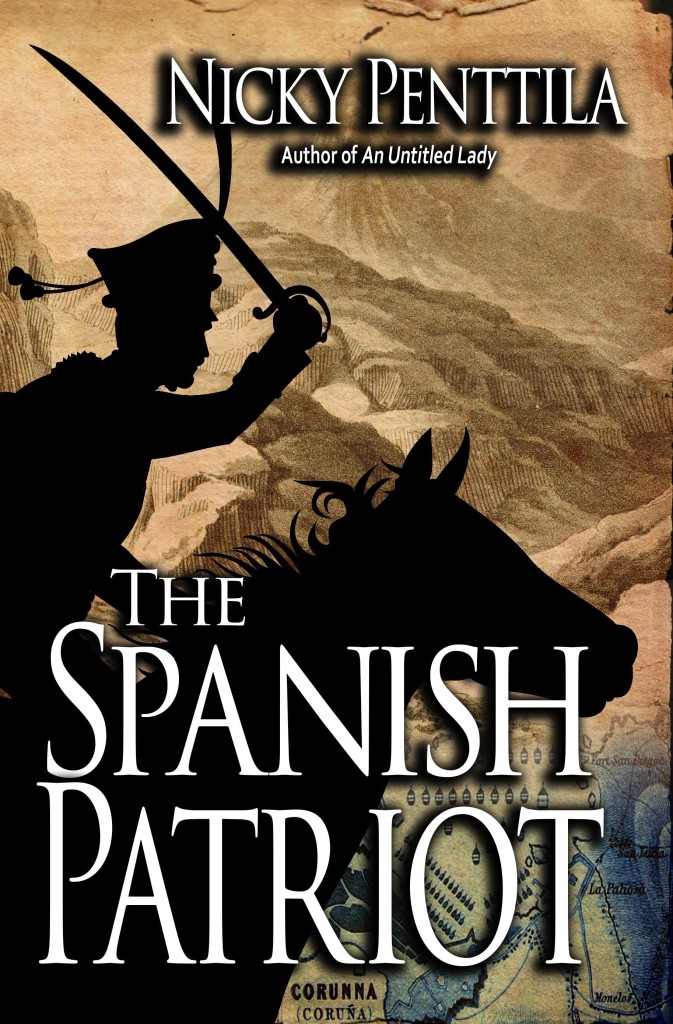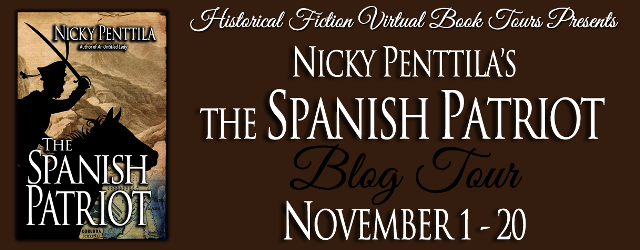Travel Adventures in the Writing of The Spanish Patriot
a guest post by Nicky Penttila, author of The Spanish Patriot
The first surprise was on arrival: I was early (8 am) arriving at the apartment I was renting for 2 weeks (my flight had been canceled because of an airline strike and I’d rebooked into a sleeper train) so the landlord wasn’t ready for me. I’d brushed up on my basic Spanish and had been getting along all right in Madrid and Seville, but here I discovered that many locals primarily speak the Galician language, gallego—including my landlord. He hadn’t finished cleaning the apartment and needed me to wait outside, which I almost figured out, but I couldn’t make him understand that I wanted to leave my big suitcase there while I wandered about.
All the emails I’d exchanged about renting the apartment and about my plans changing had been with his sister, who was at university. We solved our troubles by having a three-way conversation with her on his cellphone—success! My lack of Galician also slowed me down at the local market, but the cashiers were patient and kind, and showed how to weigh my leeks and spinach and label them. How bewildering and intimidating US self-checkout must look to a non-English speaker!
I had a bit of panic at the language in terms of my story, too; I already knew I’d need to include Spanish speakers and English speakers, and was trying to figure out how to show that distinction to people reading in English only; now would I need to distinguish Galician speakers, as well? How did my research not turn this up? Well, it turns out the period of the 1600s through early 1800s is considered “the dark ages of Galician,” when it was downgraded to a dialect (though it sounds so different!); most literary and all legal documents were written in Castilian, and that’s what the elites in cities and towns spoke. So Castilian is what Doña Sofia and the governor of La Coruña speak in my story. During the 19th century there was a renaissance of Galician, through literature and political intent; now the language is co-official with Castilian, taught in school, and I heard it everywhere, on the street, on radio, and on TV.
The second surprise was the heating. My host showed me the bank of tall windows and pantomimed how I should close the blinds and shutters as the sun was going down to keep keeping the warmed air inside. Because there was no heat! Just like I’d read about in the 1800s, with the ladies of the house closing shutters as part of household routine. Unlike the smoky-coal braziers they used, I had a nice little electric radiator, which I kept close by and dragged from living room to bedroom at night. Nighttime temperatures during my visit in May were mid-50s (Fahrenheit); that’s what the daytime average is in the winter, when my story is mainly set. Glad I visited in the spring, though.
The best surprise was how much history I could see in the city. My apartment was between the Old City, still partly surrounded by a Roman wall, and the Tower of Hercules, first built before the year 200 (not a typo), considered to be the oldest existing lighthouse in the world. I walked the path up and down the two miles of hills that my people would take to get to the beach beside the tower, and found it not as windy as I expected, and in the sun, not as cold. The city of La Coruña at my time was much smaller, just a spit of land shaped like a mushroom growing into the sea, with the tower and old city in the cap and the merchants and working classes along the stalk.
The air is loud with water, with heavy surf on Riazor Beach and breakers outside the port of La Coruña on the other side of the stalk. The skies are quick to change from rain for a few minutes back to sharp sun. As for food, plenty of pulpo (octopus) and potatoes, just like my Wakefields eat in the story.
I toured Santiago Church, a small pilgrimage church that is a setting for a few important scenes in the story, and scoped out a few buildings that I could rework into residences for my people. The city’s little military museum had a whole room on the Napoleonic wars, including a diorama of the Battle of Corunna (also called the Battle of Elviña), which really helped me see where the units were in relation to the hills and rivers.
In my Spanish classes, I’d learned of southern Spain, but the western part, Galicia, has its own stories. The people seemed calm and not outgoing to this stranger. But whenever I asked for help—in my creaky Castilian—they went out of their way to assist me. A lady in the military museum ran across the street to another building to grab me a better walking map! The policeman I asked for directions took my arm gently as if leading me onto the dance floor and turned us both 45 degrees to show me the way to the tourist office, a different sense of personal space than I’m used to.
All this went into the story, in some way or another. I think I could have written it without the visit, but being there made it real to me in a way I hope translated to the page.
See more photos from my trip HERE!
ABOUT THE AUTHOR
WEBSITE | BLOG | TWITTER | TUMBLR | GOOGLE+ | GOODREADS | PINTEREST
The Spanish Patriot by Nicky Penttila
Publication Date: September 3, 2015Wondrous Press
Formats: eBook, Paperback, Audio
Genre: Historical Fiction
READ AN EXCERPT
Some fly to war. Others flee it. No one is safe. When the British army is sent into Spain to help expel Napoleon’s invaders, nothing goes as expected. Not for London newsman Sam Kerr, hunting a story that will win him the editor’s chair, who discovers one that could wreck his career. Not for the Wakefield family, loyalist refugees from America seeking peace among people of their faith, who find war has followed them even here. And certainly not for the British troops, whose mission of support turns into a fight for all their lives. Historical fiction set in Corunna 1808.
AMAZON | BARNES & NOBLE | INKTERA | ITUNES (AUDIOBOOK) | KOBO | SMASHWORDS
PRAISE FOR AN UNTITLED LADY
“Penttila shows a deft hand with complex, believable characterizations that accurately reflect the historical period.”–Publishers Weekly“The social turmoil in Manchester leading to the Peterloo Massacre of 1819 is the unusual setting for Penttila’s quietly stunning, memorable debut novel. A very highly recommended book.”–Historical Novel Society




Thanks for inviting me! I love talking travel adventures.
ReplyDelete